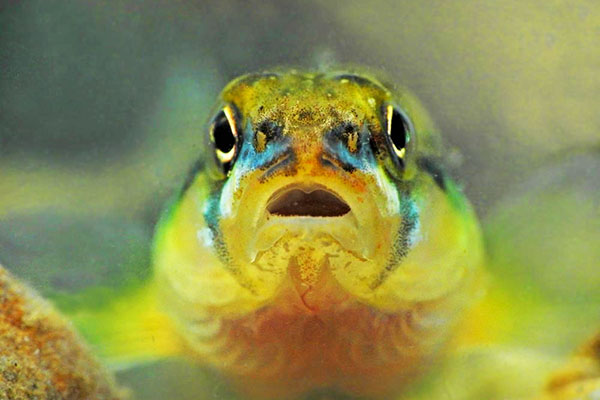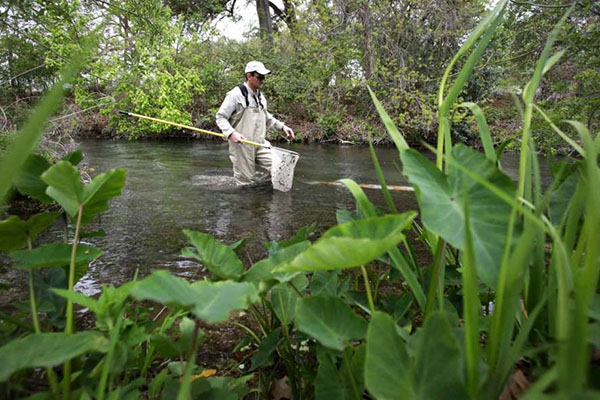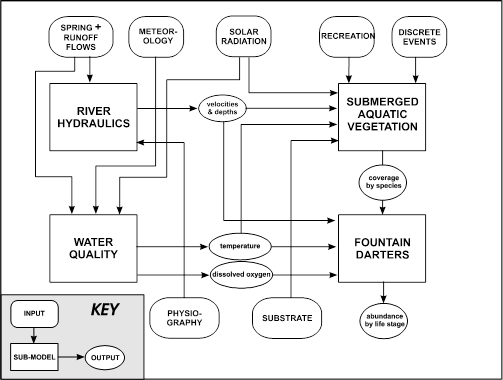Supporting Measures
- Net Disturbance & Incidental Take
- Applied Research
- Ecological Model
- Biological Monitoring
- Expanded Water Quality Monitoring
- Refugia
Net Disturbance & Incidental Take
The Incidental Take Permit (ITP) issued to the Edwards Aquifer Recovery Implementation Program by the U.S. Fish & Wildlife Services authorizes “take” of certain species (“Covered Species”) resulting from aquifer groundwater pumping and recreational and other activities in the Comal and San Marcos springs and river systems.
This “take” is authorized with the provision that a habitat conservation plan to protect the Covered Species is implemented—hence, the Edwards Aquifer Habitat Conservation Plan (EAHCP). The accurate and timely measurement of take—broadly defined as “anything that disrupts the routine activities of the Covered Species”—is fundamental to compliance with the ITP.
For more information concerning take assessment, how the HCP conducts this assessment in the Comal and San Marcos systems, and assessments conducted to date, please read more on the Net Disturbance & Incidental Take page.
More Info
Overview
The Incidental Take Permit (ITP) issued to the Edwards Aquifer Recovery Implementation Program by the U.S. Fish & Wildlife Service authorizes “take” of certain species (“Covered Species”) resulting from aquifer groundwater pumping and recreational and other activities in the Comal and San Marcos springs and river systems.
The accurate and timely measurement of “take” is fundamental to compliance with the ITP. This take is authorized with the provision that a habitat conservation plan to protect the Covered Species is implemented—hence, the Edwards Aquifer Habitat Conservation Plan (EAHCP).
This page provides definitions for terminology associated with take, followed by an overview of how take is calculated for one of the EAHCP’s Covered Species. Each of the Incidental Take/Net Disturbance Assessments conducted to date in support of the EAHCP can be accessed below.
Annual Assessments
 Net Disturbance & Incidental Take Assessment for 2024 EARIP ITP Annual Report
Net Disturbance & Incidental Take Assessment for 2024 EARIP ITP Annual Report
 Net Disturbance & Incidental Take Assessment for 2023 EARIP ITP Annual Report
Net Disturbance & Incidental Take Assessment for 2023 EARIP ITP Annual Report
 Net Disturbance & Incidental Take Assessment for 2022 EARIP ITP Annual Report
Net Disturbance & Incidental Take Assessment for 2022 EARIP ITP Annual Report
 Net Disturbance & Incidental Take Assessment for 2021 EARIP ITP Annual Report
Net Disturbance & Incidental Take Assessment for 2021 EARIP ITP Annual Report
 Net Disturbance & Incidental Take Assessment for 2020 EARIP ITP Annual Report
Net Disturbance & Incidental Take Assessment for 2020 EARIP ITP Annual Report
 Net Disturbance & Incidental Take Assessment for 2019 EARIP ITP Annual Report
Net Disturbance & Incidental Take Assessment for 2019 EARIP ITP Annual Report
 Net Disturbance & Incidental Take Assessment for 2018 EARIP ITP Annual Report
Net Disturbance & Incidental Take Assessment for 2018 EARIP ITP Annual Report
 Net Disturbance & Incidental Take Assessment for 2017 EARIP ITP Annual Report
Net Disturbance & Incidental Take Assessment for 2017 EARIP ITP Annual Report
 Net Disturbance & Incidental Take Assessment for 2016 EARIP ITP Annual Report
Net Disturbance & Incidental Take Assessment for 2016 EARIP ITP Annual Report
 Net Disturbance & Incidental Take Assessment for 2015 EARIP ITP Annual Report
Net Disturbance & Incidental Take Assessment for 2015 EARIP ITP Annual Report
 Net Disturbance & Incidental Take Assessment for 2014 EARIP ITP Annual Report
Net Disturbance & Incidental Take Assessment for 2014 EARIP ITP Annual Report
 Net Disturbance Assessment for 2013 EARIP ITP Annual Report
Net Disturbance Assessment for 2013 EARIP ITP Annual Report
 Incidental Take Assessment for 2013 EARIP ITP Annual Report
Incidental Take Assessment for 2013 EARIP ITP Annual Report

“Take” Terminology
Take
Section 3(19) of the ESA defines “take” as “to harass, harm, pursue, hunt, shoot, wound, kill, trap, capture, or collect, or to attempt to engage in any such conduct.”
- “Harass” is further defined to include acts or omissions that create the likelihood of injury to a listed species by annoying them to the point as to significantly disrupt normal behavioral patterns (e.g., breeding, feeding and sheltering) (50 CFR 17.3).
- “Harm” is further defined to include significant habitat modification or degradation that results in death or injury to listed species by significantly impairing essential behavioral patterns (e.g., breeding, feeding, and sheltering) (50 CFR 17.3).
Broadly speaking then, under these definitions, if one does anything (intentionally or negligently) that disrupts the routine activities of a Covered Species, one has committed a take of that species.
Incidental Take
Take that is otherwise prohibited under Section 9 of the ESA if such take is incidental to, but is not the purpose of, the carrying out of an otherwise lawful activity (ESA § 10(a)(1)(B)).
Incidental Take Permit (“ITP”)
This is a specific permit issued by the FWS under Section 10(a) of the ESA to private parties that are conducting otherwise lawful activities, but not for the purpose of take, that might result in the taking of listed endangered or threatened species. An ITP will have specific requirements, including (but not limited to) the preparation and implementation of a habitat conservation plan (“HCP”) which is designed to minimize and mitigate the impact of the incidental take.
EAHCP Covered Species
Eleven (11) species are covered by the EAHCP. Eight (8) are listed by the FWS as endangered or threatened, and three (3) are petitioned for listing and have been included in the event that they are listed. The following species that are authorized for incidental take in the ITP are:
- Fountain darter (endangered)
- Comal Springs riffle beetle (endangered)
- Comal Springs dryopid beetle (endangered)
- Peck’s cave amphipod (endangered)
- Texas blind salamander (endangered)
- San Marcos salamander (threatened)
- San Marcos gambusia (endangered)
Although the Texas cave diving beetle, Texas troglobitic water slater, and Comal Springs salamander are covered by the ITP as petitioned species, incidental take assessments are not performed at this time because none of these species are yet federally listed. Incidental take assessments for the San Marcos gambusia (presumed to be extinct) will be performed only if they are rediscovered to exist in the Comal or San Marcos springs and river ecosystems. Because the Section 9 take prohibitions do not apply to listed plant species, Texas wild-rice being a plant, is not subject to this prohibition. However, FWS cannot issue an ITP unless it makes a “no jeopardy or adverse modification” determination under Section 7(a)(2). Therefore, although it is not necessary for Texas wild-rice to receive incidental take coverage under the ITP, it is nonetheless included to avoid any jeopardy/adverse modification issues. For these reasons, Paragraph H of the ITP does not set out a numerical value for authorized incidental take of Texas wild-rice, and for this reason incidental take assessments are not performed for this species.
Total Occupied Habitat
This is the total area within the Comal and San Marcos springs and river ecosystems that has been historically documented as occupied by the listed EAHCP Covered Species. Total Occupied Habitat will vary by species, and between species their Total Occupied Habitats may also overlap.
Occupied Habitat Disturbed
This is the portion of occupied habitat that overlies the Total Occupied Habitat disturbed by EAHCP activities for a given EAHCP Covered Species per ecosystem. Occupied Habitat Disturbed will vary by species, and between species their Occupied Habitats Disturbed may also overlap.
Calculating Take Under the ITP
First, determine the Total Occupied Habitat (submerged aquatic vegetation, spring orifice, etc.) for each species. Next, the Occupied Habitat Disturbed by EAHCP activities in a calendar year has to be determined and overlain on the Total Occupied Habitat to determine the “footprint” of the EAHCP activities giving rise to incidental take. The two categories of EAHCP activities that may give rise to incidental take specific to the EAHCP are:
- Direct HCP mitigation and restoration – The incidental take associated with implementation of EAHCP mitigation and restoration activities. Per the ITP, such activities are limited to no more than 10% of the Total Occupied Habitat on an annual basis when implementing restoration that may directly or indirectly affect the EAHCP Covered Species.
- All other HCP activities – The incidental take associated with implementation of all the other EAHCP activities (incorporating drought impacts), to the degree practical.
Once the Total Occupied Habitat and the Occupied Habitat Disturbed for each species have been determined for the two categories of activities, the percentage of Total Occupied Habitat Disturbed relative to Occupied Habitat Disturbed can be calculated. This calculation simply represents the amount of Total Occupied Habitat that was disturbed during a calendar year due to EAHCP activities, which is a necessary variable of the annual incidental take equation, but is not itself in isolation sufficient to calculate incidental take. Following this, long-term collection data on the EAHCP Covered Species and their occupied habitat is used to develop density (individuals/m2) descriptive statistics (percentiles, median, & mean) to use in the formal calculation of incidental take. For example, if the 25th-percentile density of species density is determined as the appropriate metric per established criteria in the methodology, this number is then multiplied by the species specific Occupied Habitat Disturbed to determine the incidental take for both categories of EAHCP activities. The incidental take for each category of activity are combined as an overall total incidental take calculation and then reported in a “net disturbance and incidental take assessment report” for each calendar year and incorporated into the annual report of the EAHCP submitted to the FWS each year by the ITP permittees.

Conclusion
Performing the incidental take/net disturbance assessment—collecting data and making calculations to account for the impacts on the Comal and San Marcos spring and river systems that occur in the course of a year, over a broad spatial extent, and through different habitat types for a diverse array of taxa—is an inherently complex task. For additional detail on the intricacies involved in these assessments and associated calculations, those interested can refer to the full memoranda provided at the top of this page. As a requirement under the ITP, these assessments are reviewed annually by the U.S. Fish & Wildlife Service via the EAHCP’s annual report to ensure permit compliance.
Applied Research
The EAHCP Applied Research program is essential in collecting data for the Ecological Model. This effort provides us with a more accurate understanding of the ecological dynamics of the Comal and San Marcos springs, particularly under low-flow conditions.
Applied Research Final Reports
2024 Final Report
2021 Final Report
2019 Final Reports
2017 Final Reports
 Statistical analysis of the Comal Springs and San Marcos Springs Long-Term Monitoring Dataset (BIO-WEST, Inc)
Statistical analysis of the Comal Springs and San Marcos Springs Long-Term Monitoring Dataset (BIO-WEST, Inc)
 Statistical analysis of the San Marcos and Comal Springs aquatic ecosystems biomonitoring dataset (Beaver Creek Consulting)
Statistical analysis of the San Marcos and Comal Springs aquatic ecosystems biomonitoring dataset (Beaver Creek Consulting)
 Distributional Patterns of Aquatic Macrophytes in the San Marcos and Comal Rivers from 2000 to 2015 (Hutchinson and Foote)
Distributional Patterns of Aquatic Macrophytes in the San Marcos and Comal Rivers from 2000 to 2015 (Hutchinson and Foote)
 Evaluation of the life history of the Comal Springs riffle beetle from egg to adult (two-year project)
Evaluation of the life history of the Comal Springs riffle beetle from egg to adult (two-year project)
2016 Final Reports
 Evaluation of the life history of the Comal Springs riffle beetle from egg to adult (two-year project) Year 1 Report – December 21, 2016
Evaluation of the life history of the Comal Springs riffle beetle from egg to adult (two-year project) Year 1 Report – December 21, 2016
 Evaluation of the trophic level status and functional feeding group categorization of larvae and adult Comal Springs riffle beetle
Evaluation of the trophic level status and functional feeding group categorization of larvae and adult Comal Springs riffle beetle
 Evaluation of the long-term elevated temperature and low dissolved oxygen tolerances of larvae and adult Comal Springs riffle beetle
Evaluation of the long-term elevated temperature and low dissolved oxygen tolerances of larvae and adult Comal Springs riffle beetle
2015 Final Reports
2014 Final Reports
 Fountain darter movement under low-flow conditions in the Comal Springs/River ecosystem
Fountain darter movement under low-flow conditions in the Comal Springs/River ecosystem
 Effects of low-flow on fountain darter reproductive effort
Effects of low-flow on fountain darter reproductive effort
 Effects of predation on fountain darters
Effects of predation on fountain darters
 Determination of limitations on Comal Springs riffle beetle plastron use during low-flow
Determination of limitations on Comal Springs riffle beetle plastron use during low-flow
 Effects of low-flow on riffle beetle survival in laboratory conditions
Effects of low-flow on riffle beetle survival in laboratory conditions
 Comal Springs riffle beetle occupancy modeling and population estimate within the Comal Springs system
Comal Springs riffle beetle occupancy modeling and population estimate within the Comal Springs system
2013 Final Reports
For this year, one master report was compiled covering all four projects.
Ecological Model
The Ecological Model was constructed to simulate population dynamics of the endangered fountain darter in response to changes in habitat conditions that might result directly or indirectly from changes in water flows within the San Marcos and Comal rivers.
The Ecological Model is comprised of four major submodels, which address river hydraulics, water quality, submerged aquatic vegetation, and the fountain darter population. The model is used as a management tool to examine the effects of alternative flow regimes and submerged aquatic vegetation assemblages on fountain darter populations. The conceptual overview is shown below.

The model was developed collaboratively by:
- Dr. William Grant (Texas A&M University)
- Dr. Todd Swannack (U.S. Army Engineer Research and Development Center)
- Dr. Hsiao-Hsuan (Rose) Wang (Texas A&M University)
- Dr. Thom Hardy (Watershed Systems Group)
- Dr. George Ward (University of Texas Austin)
- Dr. Robert Doyle (Baylor University)
- Dr. Timothy Bonner (Texas State University)
- Mr. Ed Oborny (BIO-WEST, Inc.)
Report Documents
 Interim Report: Predictive Ecological Model for the Comal and San Marcos Ecosystems Project
Interim Report: Predictive Ecological Model for the Comal and San Marcos Ecosystems Project
 National Academy of Sciences Evaluation of the Predictive Ecological Model for the EAHCP: An Interim Report
National Academy of Sciences Evaluation of the Predictive Ecological Model for the EAHCP: An Interim Report
 National Academy of Sciences Evaluation of the Predictive Ecological Model for the EAHCP: An Interim Report
National Academy of Sciences Evaluation of the Predictive Ecological Model for the EAHCP: An Interim Report
 Final Report: Fountain Darter Modeling System for the Comal and San Marcos Rivers
Final Report: Fountain Darter Modeling System for the Comal and San Marcos Rivers
Biological Monitoring
A comprehensive biological monitoring program was established by the EAA in 2000 to gather baseline and critical period data to fill important data gaps in the ecological conditions of the Comal and San Marcos springs ecosystems. This comprehensive monitoring plan will continue to accumulate data for refinement of estimates of “average” conditions. Additional monitoring during low-flow periods will enhance knowledge about the species during various conditions.
Biological Monitoring Annual Reports
2025 Annual Reports
Comal Springs (available March 2026)
San Marcos Springs (available March 2026)
2024 Annual Reports
2023 Annual Reports
2022 Annual Reports
2021 Annual Reports
2020 Annual Reports
2019 Annual Reports
2018 Annual Reports
2017 Annual Reports
2016 Annual Reports
2015 Annual Reports
2014 Annual Reports
2014 Low-Flow Memoranda
 Week 1: Biological Monitoring Memorandum
Week 1: Biological Monitoring Memorandum
 Week 2: Biological Monitoring Memorandum
Week 2: Biological Monitoring Memorandum
 Week 3: Biological Monitoring Memorandum
Week 3: Biological Monitoring Memorandum
 Week 4: Biological Monitoring Memorandum
Week 4: Biological Monitoring Memorandum
 Week 5: Biological Monitoring Memorandum
Week 5: Biological Monitoring Memorandum
 Week 6: Biological Monitoring Memorandum
Week 6: Biological Monitoring Memorandum
 Week 7: Biological Monitoring Memorandum
Week 7: Biological Monitoring Memorandum
 Week 8: Biological Monitoring Memorandum
Week 8: Biological Monitoring Memorandum
 Week 9: Biological Monitoring Memorandum
Week 9: Biological Monitoring Memorandum
 Week 10: Biological Monitoring Memorandum
Week 10: Biological Monitoring Memorandum
 Week 11: Biological Monitoring Memorandum
Week 11: Biological Monitoring Memorandum
 Week 12: Biological Monitoring Memorandum
Week 12: Biological Monitoring Memorandum
 Week 13: Biological Monitoring Memorandum
Week 13: Biological Monitoring Memorandum
 Week 14: Biological Monitoring Memorandum
Week 14: Biological Monitoring Memorandum
 Week 15: Biological Monitoring Memorandum
Week 15: Biological Monitoring Memorandum
 Week 16: Biological Monitoring Memorandum
Week 16: Biological Monitoring Memorandum
 Week 17: Biological Monitoring Memorandum
Week 17: Biological Monitoring Memorandum
 Week 18: Biological Monitoring Memorandum
Week 18: Biological Monitoring Memorandum
 Week 19: Biological Monitoring Memorandum
Week 19: Biological Monitoring Memorandum
 Week 20: Biological Monitoring Memorandum
Week 20: Biological Monitoring Memorandum
 Week 21: Biological Monitoring Memorandum
Week 21: Biological Monitoring Memorandum
 Week 22: Biological Monitoring Memorandum
Week 22: Biological Monitoring Memorandum
 Week 23: Biological Monitoring Memorandum
Week 23: Biological Monitoring Memorandum
 Week 24: Biological Monitoring Memorandum
Week 24: Biological Monitoring Memorandum
 Week 25: Biological Monitoring Memorandum
Week 25: Biological Monitoring Memorandum
 Week 26: Biological Monitoring Memorandum
Week 26: Biological Monitoring Memorandum
 Week 27: Biological Monitoring Memorandum
Week 27: Biological Monitoring Memorandum
 Week 28: Biological Monitoring Memorandum
Week 28: Biological Monitoring Memorandum
 Week 29: Biological Monitoring Memorandum
Week 29: Biological Monitoring Memorandum
 Week 30: Biological Monitoring Memorandum
Week 30: Biological Monitoring Memorandum
 Week 31: Biological Monitoring Memorandum
Week 31: Biological Monitoring Memorandum
 Week 32: Biological Monitoring Memorandum
Week 32: Biological Monitoring Memorandum
 Week 33: Biological Monitoring Memorandum
Week 33: Biological Monitoring Memorandum
 Week 34: Biological Monitoring Memorandum
Week 34: Biological Monitoring Memorandum
 Week 35: Biological Monitoring Memorandum
Week 35: Biological Monitoring Memorandum
 Week 36: Biological Monitoring Memorandum
Week 36: Biological Monitoring Memorandum
 Week 37: Biological Monitoring Memorandum
Week 37: Biological Monitoring Memorandum
 Week 38: Biological Monitoring Memorandum
Week 38: Biological Monitoring Memorandum
 Week 39: Biological Monitoring Memorandum
Week 39: Biological Monitoring Memorandum
 Week 40: Biological Monitoring Memorandum
Week 40: Biological Monitoring Memorandum
 Week 41: Biological Monitoring Memorandum
Week 41: Biological Monitoring Memorandum
2013 Annual Reports
2013 Low-Flow Memoranda
 Week 1: August 16, 2013, Biological Monitoring Memorandum
Week 1: August 16, 2013, Biological Monitoring Memorandum
 Week 2: August 23, 2013, Biological Monitoring Memorandum
Week 2: August 23, 2013, Biological Monitoring Memorandum
 Week 3: August 30, 2013, Biological Monitoring Memorandum
Week 3: August 30, 2013, Biological Monitoring Memorandum
 Week 4: September 06, 2013, Biological Monitoring Memorandum
Week 4: September 06, 2013, Biological Monitoring Memorandum
 Week 5: September 13, 2013, Biological Monitoring Memorandum
Week 5: September 13, 2013, Biological Monitoring Memorandum
 Week 6: September 20, 2013, Biological Monitoring Memorandum
Week 6: September 20, 2013, Biological Monitoring Memorandum
 Week 7: September 27, 2013, Biological Monitoring Memorandum
Week 7: September 27, 2013, Biological Monitoring Memorandum
 Week 8: October 4, 2013, Biological Monitoring Memorandum
Week 8: October 4, 2013, Biological Monitoring Memorandum
 Week 9: October 11, 2013, Biological Monitoring Memorandum
Week 9: October 11, 2013, Biological Monitoring Memorandum
 Week 10: October 18, 2013, Biological Monitoring Memorandum
Week 10: October 18, 2013, Biological Monitoring Memorandum
 Week 11: October 25, 2013, Biological Monitoring Memorandum
Week 11: October 25, 2013, Biological Monitoring Memorandum
 Week 12: November 1, 2013, Biological Monitoring Memorandum
Week 12: November 1, 2013, Biological Monitoring Memorandum
Expanded Water Quality Monitoring
The EAA operates water quality monitoring programs in the Comal and San Marcos Rivers as a part of the EAHCP.
Annual Expanded Water Quality Monitoring Reports
2019
2013
 Edwards Aquifer Habitat Conservation Plan – Expanded Water Quality Monitoring Report
Edwards Aquifer Habitat Conservation Plan – Expanded Water Quality Monitoring Report
 Real Time Monitoring Results (Dry Comal)
Real Time Monitoring Results (Dry Comal)
 Real Time Monitoring Results (Rio Vista)
Real Time Monitoring Results (Rio Vista)
 Real Time Monitoring Results (Spring Run III)
Real Time Monitoring Results (Spring Run III)
 Real Time Monitoring Results (University Drive)
Real Time Monitoring Results (University Drive)
 Sediment Sampling, Comal System, Part I
Sediment Sampling, Comal System, Part I
 Sediment Sampling, Comal System, Part II
Sediment Sampling, Comal System, Part II
 Sediment Sampling, Comal System, Part III and Sediment Sampling, San Marcos System, Part I
Sediment Sampling, Comal System, Part III and Sediment Sampling, San Marcos System, Part I
 Sediment Sampling, San Marcos System, Part II
Sediment Sampling, San Marcos System, Part II
 Sediment Sampling, San Marcos System, Part III
Sediment Sampling, San Marcos System, Part III
 Comal System Stormwater Sampling
Comal System Stormwater Sampling
 Comal System Stormwater Sampling Level II
Comal System Stormwater Sampling Level II
 Revised Comal System Stormwater Sampling
Revised Comal System Stormwater Sampling
 San Marcos System Stormwater Sampling
San Marcos System Stormwater Sampling
 Comal River Surface Water Analytical Report by TestAmerica
Comal River Surface Water Analytical Report by TestAmerica
 Comal River Surface Water Bacteria Analytical Report by the San Antonio River Authority
Comal River Surface Water Bacteria Analytical Report by the San Antonio River Authority
 San Marcos River Surface Water Bacteria Analytical Report by the San Antonio River Authority
San Marcos River Surface Water Bacteria Analytical Report by the San Antonio River Authority
 San Marcos River Surface Water Analytical Report by TestAmerica Part II
San Marcos River Surface Water Analytical Report by TestAmerica Part II
 San Marcos River Surface Water Analytical Report by TestAmerican Part I
San Marcos River Surface Water Analytical Report by TestAmerican Part I
 Additional San Marcos River Surface Water Bacteria Analytical Data by the San Antonio River Authority
Additional San Marcos River Surface Water Bacteria Analytical Data by the San Antonio River Authority
Refugia
EAA will support and coordinate the construction of an off-site refugia facility in order to preserve the covered species population in the event of a catastrophic event such as the unexpected loss of springflow or a chemical spill.
Refugia Annual Reports
Refugia Research Reports
Find Out About the EAHCP
The Edwards Aquifer Habitat Conservation Plan
The Partners
Contact Information
EAHCP
EAHCP Steward Newsletter
Stay in touch with all of the happenings of the Edwards Aquifer Habitat Conservation Plan.

 Aquifer Conditions
Aquifer Conditions
 CURRENT
CURRENT 
